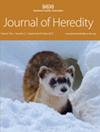Genetic Re-assessment of Population Subdivision in Yellowstone National Park Bison
IF 2.5
2区 生物学
Q2 EVOLUTIONARY BIOLOGY
引用次数: 0
Abstract
Yellowstone National Park is home to the only plains bison population that has continually existed as wildlife, on the same landscape, through the population bottleneck of the late 19th century. Nevertheless, by the early 1900s, only 23 wild bison were known to have survived poaching. Salvation efforts included the addition of 18 females from Montana and 3 bulls from Texas to augment this population. A century later, nuclear microsatellite-based population level assessment revealed two genetically distinct bison sub-populations. However, in 2016 an analysis of mitochondrial haplotypes showed the two founding lineages were distributed throughout the park. This study is designed to delineate any current sub-structure in the Yellowstone bison population by strategically sampling the two major summer breeding herds and the two major winter ranges. Population level metrics were derived using the same microsatellite loci as the original study along with a newly developed set of highly informative bison specific Single Nucleotide Polymorphisms (SNPs). Our analyses reveal that the modern bison in Yellowstone National Park currently consist of one interbreeding population, comprised of two subunits.黄石国家公园野牛种群细分的基因再评估
黄石国家公园是唯一一个平原野牛种群的家园,在 19 世纪末的种群瓶颈期,这些野牛一直作为野生动物生存在同一片土地上。然而,到 20 世纪初,已知只有 23 头野生野牛在偷猎中幸存下来。拯救工作包括从蒙大拿州引进 18 头雌性野牛和从得克萨斯州引进 3 头雄性野牛,以扩大这一种群。一个世纪后,基于核微卫星的种群水平评估发现了两个基因上截然不同的野牛亚种群。然而,2016 年对线粒体单倍型的分析表明,这两个始祖系分布在整个公园。本研究旨在通过对两个主要的夏季繁殖群和两个主要的冬季牧场进行战略性采样,划定黄石野牛种群目前的任何亚结构。使用与原始研究相同的微卫星位点以及新开发的一组具有高度信息量的野牛特异性单核苷酸多态性(SNPs),得出了种群水平指标。我们的分析表明,黄石国家公园中的现代野牛目前由一个杂交种群和两个亚单位组成。
本文章由计算机程序翻译,如有差异,请以英文原文为准。
求助全文
约1分钟内获得全文
求助全文
来源期刊

Journal of Heredity
生物-遗传学
CiteScore
5.20
自引率
6.50%
发文量
63
审稿时长
6-12 weeks
期刊介绍:
Over the last 100 years, the Journal of Heredity has established and maintained a tradition of scholarly excellence in the publication of genetics research. Virtually every major figure in the field has contributed to the journal.
Established in 1903, Journal of Heredity covers organismal genetics across a wide range of disciplines and taxa. Articles include such rapidly advancing fields as conservation genetics of endangered species, population structure and phylogeography, molecular evolution and speciation, molecular genetics of disease resistance in plants and animals, genetic biodiversity and relevant computer programs.
 求助内容:
求助内容: 应助结果提醒方式:
应助结果提醒方式:


